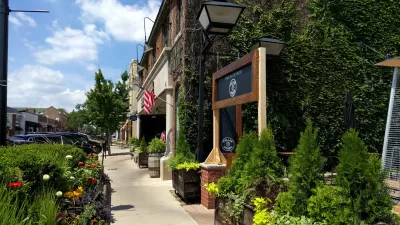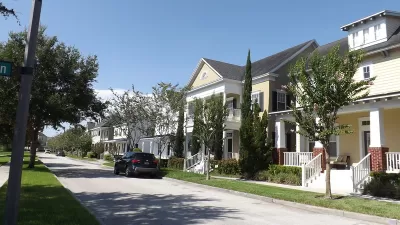Instead of always fighting to make sprawl development harder, let's focus our energy on making great infill development easier.
It seems fitting to start a new blog with a sweeping declaration so here’s one to shout from the rooftops: sprawl is bad. By contrast, infill is good. And despite the recession, the two development types constantly compete for our housing dollars. Consider your own decisions. You, as a planner, have faced the choice of where to purchase a home. In your own personal way, you have debated the trade-offs of living in a bedroom community versus the heart of the city. How often have you chosen to live in the city? Or rather, how often do you get a choice?
Whatever the answer, it usually comes down to the availability and affordability of quality infill. If it’s there and we can afford it, we naturally select it. We’re planners, after all. But the opportunity is rare in most communities.
Indeed, there’s nothing more tragic than the fact that many of us who help build great communities can’t afford to live there. And as housing demand (and the pressure of sprawl) begins to mature this summer, we may lose a powerful opportunity to gain ground on this issue.
Over the years, the communities I’ve served have tried everything to curb sprawl. They’ve taken cues from case studies, applied tactics from toolkits, and earned scars from plans gone sour. Every proposal has tested the limits of a community’s will to change.
In every project, we’ve tried fighting sprawl by adding more demanding regulation. TDRs, TODs, and UGBs. Overlays, density caps, impact fees, and more.
Few solutions have been effective. In fact, the only thing to truly stop sprawl was the recession.
So here’s a different approach: as housing markets return, let’s ignore sprawl policies for a while and focus on infill policy instead. And let’s address infill in a completely new way.
If you accept the fact that sprawl and infill compete for the same consumer, what if we tilted the fight? What if we gave great infill development a real competitive advantage? Specifically, what if we removed barriers for great infill instead of making new barriers for sprawl? Economically, if great infill were easier to develop than sprawl, there would be more of it in many cities.
Bear in mind that the idea isn’t to make any infill easy--only great infill. And what is great infill? Anything that fits your city’s plan. This is the vital part of the equation: a city must have a clear definition of great (infill) development expressed in a visual manner. This seems obvious but it often goes overlooked.
The next step is where we can really change course: from the plan (i.e., the visual definition of ideal development), we define the absolute least amount of rules necessary to make the ideal possible. Whatever that is, we write it into law and dispose the rest. We make a lean, strategic, purpose-driven policy.
Take my city, Columbia, Tennessee, as an example. Here, we recently defined great infill in each basic context (suburban, urban, etc.), grabbed a blank sheet of paper, and wrote an entirely new development policy [PDF]. This clean slate helped us discover what policies were irrelevant or, worse, detrimental to the cause. It also helped us understand why we had so much more sprawl than originally intended. Our old books weren’t based on a vision. There was no lucid picture of great development. There were just generic rules applied unilaterally. So infill and sprawl were treated the same. Same basic zoning categories, same use restrictions, same parking requirements, same review processes.
This equal treatment is a disaster. History shows that when sprawl and infill are treated the same (i.e., same rules, same process), sprawl wins. It costs less and faces less uncertainty in the public review.
Indeed, the uncertainty of public review processes has been especially harmful to infill efforts. By nature, infill development affects more neighbors and thus more people attend meetings and voice concerns. All the while, a new subdivision on the edge of a greenfield garners little attention. Fewer live next to it and, thus, fewer are aware or concerned.
So again, when we visually defined great development in our city and wrote our policies around the ideal, we learned what mattered most: the scale of buildings, their placement relative to the street, and some basic architectural elements were crucial. But land uses? Those were secondary. Density? Completely irrelevant. And parking? Parking minimums were often one of the biggest limitations to people reusing old buildings. So we got rid of them where we could.
We found what mattered most, codified those values, and got rid of the rest. No more lot requirements, no more density, no more parking minimums. No more arbitrary conventions written for the purpose of being “comprehensive”. We decided to be cohesive instead. Our new set of rules provides a powerful incentive for infill. If someone meets the small set of vital requirements, they will create great infill development by default and the city can approve the project immediately. This is a boon for the entire community.
This is also where the approach differs from other coding efforts. We know about Miami, Denver, and Cincinnati. Each replaced their codes with something new and fantastic. But what works for these major metropolitans cannot work in the smaller edge cities that experience the more direct pressure of sprawl.
To conclude, I’m a public sector planner so it feels strange to write this but here goes: getting rid of regulations has been a liberating experience. Knowing what we want has allowed us to ask for less. For this reason, we’re now encouraging infill not by adding incentives but by removing arbitrary requirements.
And sprawl? There’s no special treatment there; nothing has changed on that side of our policy. We still heap a great deal of public review on edge developments and scrutinize the impact to our services and character. There’s the same amount of uncertainty and same costs as before. The difference is that it’s now harder to do edge development since infill is made easier. Is it a perfect approach? No, but it’s a better paradigm. It changes the game and accomplishes a core edict that a friend of mine has always advised: make it easy to do the right thing.

Maui's Vacation Rental Debate Turns Ugly
Verbal attacks, misinformation campaigns and fistfights plague a high-stakes debate to convert thousands of vacation rentals into long-term housing.

Planetizen Federal Action Tracker
A weekly monitor of how Trump’s orders and actions are impacting planners and planning in America.

San Francisco Suspends Traffic Calming Amidst Record Deaths
Citing “a challenging fiscal landscape,” the city will cease the program on the heels of 42 traffic deaths, including 24 pedestrians.

Defunct Pittsburgh Power Plant to Become Residential Tower
A decommissioned steam heat plant will be redeveloped into almost 100 affordable housing units.

Trump Prompts Restructuring of Transportation Research Board in “Unprecedented Overreach”
The TRB has eliminated more than half of its committees including those focused on climate, equity, and cities.

Amtrak Rolls Out New Orleans to Alabama “Mardi Gras” Train
The new service will operate morning and evening departures between Mobile and New Orleans.
Urban Design for Planners 1: Software Tools
This six-course series explores essential urban design concepts using open source software and equips planners with the tools they need to participate fully in the urban design process.
Planning for Universal Design
Learn the tools for implementing Universal Design in planning regulations.
Heyer Gruel & Associates PA
JM Goldson LLC
Custer County Colorado
City of Camden Redevelopment Agency
City of Astoria
Transportation Research & Education Center (TREC) at Portland State University
Jefferson Parish Government
Camden Redevelopment Agency
City of Claremont





























